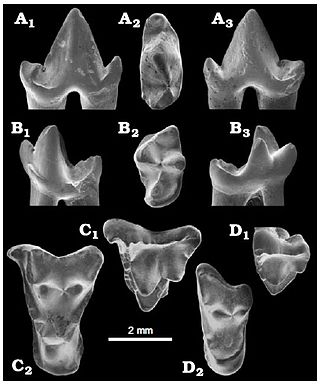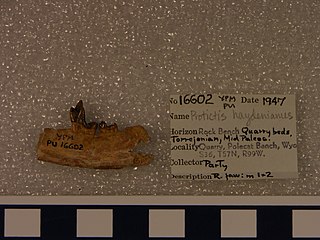
Carnivoramorpha is a clade of placental mammals of clade Pan-Carnivora from mirorder Ferae, that includes the modern order Carnivora and its extinct stem-relatives.

Ernanodon is an extinct genus of placental mammal from extinct family Ernanodontidae within extinct order Palaeanodonta, that lived from the middle to late Paleocene in China and Mongolia.

Vulpavus is an extinct paraphyletic genus of placental mammals from clade Carnivoraformes, that lived in North America from early to middle Eocene.

Oodectes is an extinct paraphyletic genus of placental mammals from clade Carnivoraformes, that lived in North America from early to middle Eocene.

Didymictis is an extinct genus of placental mammals from extinct subfamily Didymictinae within extinct family Viverravidae, that lived in North America and Europe from the late Paleocene to middle Eocene.

Epoicotheriidae is an extinct paraphyletic family of insectivorous placental mammals within extinct order Palaeanodonta, that lived in North America, Asia and Europe from the late Paleocene to early Oligocene. Epoicotheriids were fossorial mammals. Late Eocene/early Oligocene genera were highly specialized animals that were convergent with the talpids, golden moles and marsupial mole in the structure of their skulls and forelimbs, and would have had a similar lifestyle as subterranean burrowers.
Escavadodon is an extinct genus of pangolin-like myrmecophagous placental mammals of extinct monotypic family Escavadodontidae within extinct order Palaeanodonta, that lived in North America during the middle Paleocene. It contains a single species, Escavadodon zygus, recovered from the Nacimiento Formation of New Mexico.

Gracilocyon is an extinct paraphyletic genus of placental mammals from clade Carnivoraformes, that lived in North America and Europe from late Paleocene to early Eocene.
The Willwood Formation is a sedimentary sequence deposited during the late Paleocene to early Eocene, or Clarkforkian, Wasatchian and Bridgerian in the NALMA classification.

Palaeanodonta is an extinct clade of stem-pangolins. They were insectivorous (myrmecophagous), possibly fossorial, and lived from the middle Paleocene to early Oligocene in North America, Europe and Asia. While the taxonomic grouping of Palaeanodonta has been debated, it is widely thought that they are a sister group to pangolins.

Ernanodontidae is an extinct family of myrmecophagous placental mammals within extinct order Palaeanodonta, that lived in Asia from the middle to late Paleocene.
Chiromyoides is a small plesiadapid primatomorph that is known for its unusually robust upper and lower incisors, deep dentary, and comparatively small cheek teeth. Species of Chiromyoides are known from the middle Tiffanian through late Clarkforkian North American Land Mammal Ages (NALMA) of western North America, and from late Paleocene deposits in the Paris Basin, France.

Pholidotamorpha is a clade of placental mammals from mirorder Ferae that includes the order Pholidota and extinct order Palaeanodonta.

Protictis is an extinct paraphyletic genus of placental mammals from extinct subfamily Didymictinae within extinct family Viverravidae, that lived in North America from early Paleocene to middle Eocene.

Xenocranium is an extinct monotypic genus of placental mammal from extinct paraphyletic subfamily Epoicotheriinae within extinct paraphyletic family Epoicotheriidae in extinct order Palaeanodonta, that lived in North America during the late Eocene.

Limnocyonidae is a family of extinct predatory mammals from extinct order Hyaenodonta. Fossil remains of these mammals are known from late Paleocene to late Eocene deposits in North America and Asia. Limnocyonids had only two molars in the upper and lower dentition.

Palaeonictinae is an extinct subfamily of placental mammals from extinct family Oxyaenidae, that lived from the late Paleocene to early Eocene of Europe and North America.

Viverravinae is an extinct subfamily of mammals from extinct family Viverravidae, that lived from the early Palaeocene to the middle Eocene in North America, Asia and Europe.

Didymictinae is an extinct subfamily of mammals from extinct family Viverravidae, that lived from the early Palaeocene to the middle Eocene in North America and Europe.

Epoicotheriinae is an extinct paraphyletic subfamily of insectivorous placental mammals within extinct paraphyletic family Epoicotheriidae in extinct order Palaeanodonta, that lived in North America and Europe from the early Eocene to early Oligocene. Epoicotheriins were fossorial mammals. Late Eocene/early Oligocene genera were highly specialized animals that were convergent with the talpids, golden moles and marsupial mole in the structure of their skulls and forelimbs, and would have had a similar lifestyle as subterranean burrowers.















